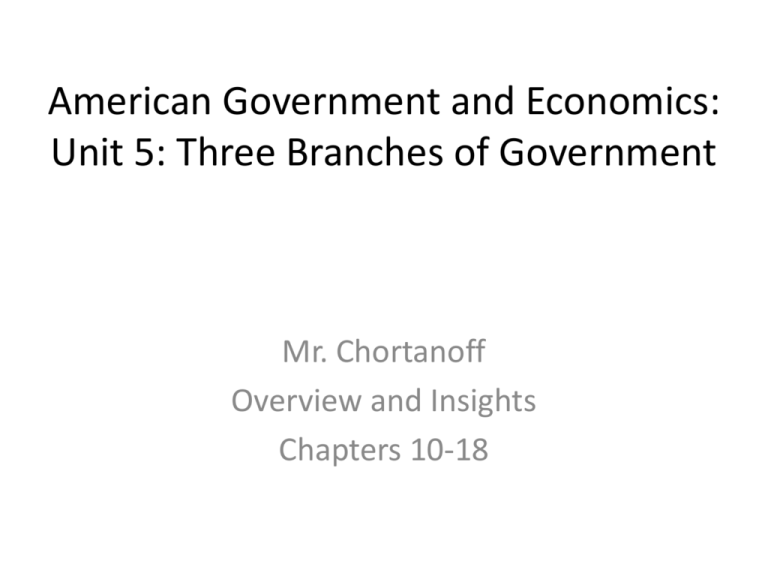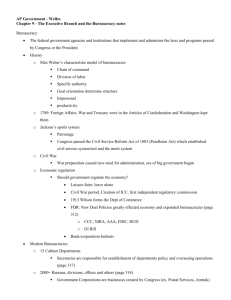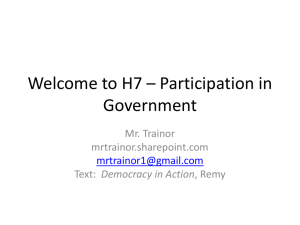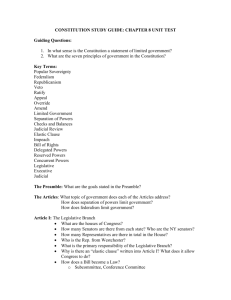American Government and Economics: Unit 5: Three Branches of
advertisement

American Government and Economics: Unit 5: Three Branches of Government Mr. Chortanoff Overview and Insights Chapters 10-18 Big Ideas: The beauty and uniqueness of American democracy exists in the division of power between three equally powerful branches of government which check and balance one another to preserve the Founding Fathers’ vision of a limited government. Unit Essential Question: What are the primary responsibilities and basic structure of our three branches of government? 3 Concepts = 3 Branches THE LEGISLATIVE BRANCH THE EXECUTIVE BRANCH THE JUDICIAL BRANCH 1. How is Congress organized? 1. How is the Executive Branch 1. How is the Federal court organized? system organized? 2. What are the powers of Congress? 2. What are the powers of the Executive Branch? 2. What are the powers of the Federal Judiciary? 3. How do bills become laws? 3. What is the bureaucracy and its functions? 3. What is judicial review? The Legislative Branch: Organization • Congress meets in the Capitol Building • Congress is divided into 2 houses (bicameral) – The House of Representatives (number is based on state population. A total of 435 members are divided among the fifty states) – The Senate (2 per state, total of 100) • Reps serve for a two year term • Senators serve for a six year term • Election requirements exist Congress works BY Committees Expressed Powers lead to Implied Powers The Executive Branch: Organization President Vice President Advisors Cabinet People Military Election? The Electoral College Voters do not vote directly for the President. Instead, they vote for electors in the Electoral College. • • All States, except two (Maine and Nebraska), select electors based on the winner of the popular vote in that State. Electors then meet in the State capitals on the Monday after the second Wednesday in December and cast their votes for President and Vice President. • On January 6, the electoral votes cast are counted by the president of the Senate, and the President and Vice President are formally elected. • If no candidate wins a majority of electoral votes (270), the election is thrown into the House of Representatives. Powers • • • • • • • • • • • • Enforce the law Protect the Constitution Make treaties (to be Senate approved) Appoint Federal Judges Appoint other Federal officers and directors (FBI, CIA) Appoint USSC Justices (to be Senate approved) Commander-in-Chief of the military (approve strategy) Recommend legislation (bills) to Congress Veto legislation Appoint ambassadors, Recall ambassadors Call special session of Congress to deal with an emergency Issue Executive Orders (rules/regs./directives) The Defense Department This chart shows the chain of command of the American military services. What Is a Bureaucracy? Bureaucracies carry out the day to day functions of government. Three features distinguish bureaucracies: • Hierarchical authority. Bureaucracies are based on a pyramid structure with a chain of command running from top to bottom. • Job specialization. Each bureaucrat, or person who works for the organization, has certain defined duties and responsibilities. • Formalized rules. The bureaucracy does its work according to a set of established regulations and procedures. The West Wing of the White House The President’s closest advisors work in the West Wing of the White House, near the oval office. Executive Departments • The executive departments, often called the Cabinet departments, are the traditional units of federal administration. They are designed to help the President understand issues, develop policies, and enforce laws. • Each department is headed by a secretary, except for the Department of Justice, whose work is directed by the attorney general. • The Department of Homeland Security is the newest one. • Today, the executive departments vary a great deal in terms of visibility, size, and importance. Major Elements of the Federal Bureaucracy The federal bureaucracy is all of the agencies, people, and procedures through which the Federal Government operates. • The President is the chief administrator of the Federal Government. • In order to enact and enforce policy, Congress and the President have created an administration—the government’s many administrators and agencies. • The chief organizational feature of the federal bureaucracy is its division into areas of specialization. Development of the Civil Service The civil service is that group of public employees who perform the administrative work of government, excluding the armed forces. • The use of patronage—the practice of giving government jobs to supporters and friends—was in use throughout most of the nineteenth century. • The Pendleton Act, also known as the Civil Service Act of 1883, laid the foundation of the present federal civil service system, and set merit as the basis for hiring in most civil service positions. The Judicial Branch: Organization US Supreme Court Federal Courts State, County, Local Courts Types of Federal Courts The Constitution created only the Supreme Court, giving Congress the power to create any lower, or “inferior,” courts as needed. 2 3 4 Chapter 18, Section 1 Powers • Interpret and apply the laws of the land • Jurisdiction is defined as the authority of a court to hear (to try and to decide) a case. Know the law Interpret the law (hear the case, review the evidence) Apply the law (decision/ruling) Justice How Federal Cases Are Appealed Appealing a Case to the Supreme Court Opinions of the USS Court Once the Court finishes its conference, it reaches a decision and its opinion is written. Majority Opinion The majority opinion, formally called the Opinion of the Court, announces the Court’s decision in a case and its reasoning on which it is based. Precedents The majority opinions stand as precedents, or examples to be followed in similar cases as they arise in the lower courts or reach the Supreme Court. Concurring Opinions Concurring opinions are sometimes authored by justices to add or emphasize a point that was not made in the majority opinion. Dissenting Opinions Dissenting opinions are often written by those justices who do not agree with the Court's majority opinion. Judicial Review • “Judicial Review” is the Judicial Branch’s check to the other two branches • “JR” refers to the power of a court to determine the constitutionality of a government action or law. • The Supreme Court first asserted its power of judicial review in the case of Marbury v. Madison (1803). • The Court’s decision laid the foundation for its involvement in the development of the American system of government.






